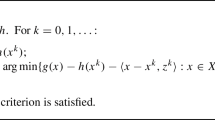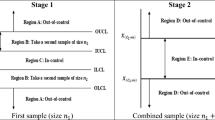Abstract
In this paper we discuss computational complexity and risk averse approaches to two and multistage stochastic programming problems. We argue that two stage (say linear) stochastic programming problems can be solved with a reasonable accuracy by Monte Carlo sampling techniques while there are indications that complexity of multistage programs grows fast with increase of the number of stages. We discuss an extension of coherent risk measures to a multistage setting and, in particular, dynamic programming equations for such problems.
Similar content being viewed by others
References
Ahmed, S., Cakmak, U., Shapiro, A.: Coherent risk measures in inventory problems. Eur. J. Oper. Res. (in press, 2007)
Artzner P., Delbaen F., Eber J.-M. and Heath D. (1999). Coherent measures of risk. Math. Financ. 9: 203–228
Artzner P., Delbaen F., Eber J.-M., Heath D. and Ku H. (2003). Coherent multiperiod risk measurement. Manuscript, ETH Zürich
Beale E.M.L. (1955). On minimizing a convex function subject to linear inequalities. J. R. Stat. Soc. B 17: 173–184
Ben-Tal, A., Nemirovski, A.: Selected topics in robust convex optimization. Math. Prog. B, this issue
Birge J.R. and Louveaux F.V. (1997). Introduction to Stochastic Programming. Springer-Verlag, New York
Blomvall J. and Shapiro A. (2007). Solving multistage asset investment problems by Monte Carlo based optimization. Math. Prog. B 108: 571–595
Casella, G., Berger, R.: Statistical Inference. 2nd Edn, Duxbury (2001)
Charnes A., Cooper W.W. and Symonds G.H. (1958). Cost horizons and certainty equivalents: an to stochastic programming of heating oil. Manage. Sci. 4: 235–263
Cheridito P., Delbaen F. and Kupper M. (2004). Coherent and convex risk measures for bounded càdlàg processes. Stochas. Processes Appl. 112: 1–22
Dantzig G.B. (1955). Linear programming under uncertainty. Manage. Sci. 1: 197–206
Delbaen, F.: Coherent risk measures on general probability spaces. Essays in Honour of Dieter Sondermann. Springer, Heidelberg (2002)
Dupačová J. (1978). Minimax approach to stochastic linear programming and the moment problem. Optimierung, Sstochastik und mathematische Methoden der Wirtschaftswissenschaften 58: 466–467
Dupačová J. (1987). The minimax approach to stochastic programming and an illustrative application. Stochastics 20: 73–88
Dyer M. and Stougie L. (2006). Computational complexity of stochastic programming problems. Math. Prog. 106(3): 423–432
Evgrafov A. and Patriksson M. (2004). On the existence of solutions to stochastic mathematical programs with equilibrium constraints. J. Optim. Theory Appl. 121: 67–76
Eichhorn A. and Römisch W. (2005). Polyhedral risk measures in stochastic programming. SIAM J. Optim. 16: 69–95
Erdoğan E. and Iyengar G. (2006). Ambiguous chance constrained problems and robust optimization. Math. Prog. 107: 37–61
Ermoliev Y., Gaivoronski A. and Nedeva C. (1985). Stochastic optimization problems with partially known distribution functions. SIAM J. Control Optim. 23: 697–716
Fletcher, R., Leyffer, S.: Numerical experience with solving MPECs as NLPs, University of Dundee Report NA210 (2002)
Föllmer H. and Schied A. (2002). Convex measures of risk and trading constraints. Financ. Stochas. 6: 429–447
Gaivoronski A. (1991). A numerical method for solving stochastic programming problems with constraints on a distribution function. Ann. Oper. Res. 31: 347–370
Heitsch, H., Römisch, W., Strugarek, C.: Stability of multistage stochastic programs. SIAM J. Optim. (in press 2007)
Homem-de-Mello, T.: On rates of convergence for stochastic optimization problems under non-i.i.d. sampling, Manuscript, Dept. of Industrial Engineering and Management Sciences, Northwestern University (2006)
Iyengar G. (2005). Robust dynamic programming Math. Oper. Res. 30: 1–21
Kall P. (1976). Stochastic Linear Programming. Springer-Verlag, Berlin
Kleywegt A.J., Shapiro A. and Homem-de-Mello T. (2001). The sample average approximation method for stochastic discrete optimization. SIAM J. Optim. 12: 479–502
Koivu M. (2005). Variance reduction in sample approximations of stochastic programs. Math. Prog. 103: 463–485
Lin G.H. and Fukushima M. (2005). A Class of stochastic mathematical programs with complementarity constraints: reformulations and algorithms. J. Indus. Manage. Optim. 1: 99–122
Linderoth J., Shapiro A. and Wright S. (2006). The empirical behavior of sampling methods for stochastic programming. Ann. Oper. Res. 142: 215–241
Mak W.K., Morton D.P. and Wood R.K. (1999). Monte Carlo bounding techniques for determining solution quality in stochastic programs. Oper. Res. Lett. 24: 47–56
Markowitz H.M. (1952). Portfolio selection. J. Financ. 7: 77–91
Nemirovski, A.: On tractable approximations of randomly perturbed convex constraints. Proceedings of the 42nd IEEE Conference on Decision and Control Maui, Hawaii USA, December 2003, 2419–2422
Nemirovski, A., Shapiro, A.: Scenario approximations of chance constraints. In: Calafiore, G., Dabbene, F. (eds.), Probabilistic and Randomized Methods for Design under Uncertainty, pp. 3–48, Springer, London (2005)
Nemirovski, A., Shapiro, A.: Convex approximations of chance constrained programs. SIAM J. Optim. (in press 2007)
Niederreiter, H.: Random Number Generation and Quasi-Monte Carlo Methods, SIAM, Philadelphia (1992)
Norkin V.I., Pflug G.Ch. and Ruszczyński A. (1998). A branch and bound method for stochastic global optimization. Math. Prog. 83: 425–450
Ogryczak W. and Ruszczyński A. (1999). From stochastic dominance to mean–risk models: semideviations as risk measures. Eur. J. Oper. Res. 116: 33–50
Olsen P. (1976). Discretization of multistage stochastic programming problems. Math. Prog. Study 6: 111–124
Patriksson M. and Wynter L. (2000). Stochastic mathematical programs with equilibrium constraints. Oper. Res. Lett. 25: 159–167
Pennanen T. (2005). Epi-convergent discretizations of multistage stochastic programs. Math. Oper. Res. 30: 245–256
Pennanen T. and Koivu M. (2005). Epi-convergent discretizations of stochastic programs via integration quadratures. Numerische Mathematik 100: 141–163
Pflug G.Ch. (2007). Subdifferential representations of risk measures. Math. Prog. 108: 339–354
Plambeck E.L., Fu B.R., Robinson S.M. and Suri R. (1996). Sample-path optimization of convex stochastic performance functions. Math. Prog. B 75: 137–176
Prékopa, A.: Stochastic Programming, Kluwer, Dordrecht, Boston (1995)
Prékopa, A.: Probabilistic programming. In: Ruszczyński, A., Shapiro, A., (eds.) Stochastic Programming, Handbook in OR & MS, vol. 10, North-Holland Publishing Company, Amsterdam (2003)
Ralph D. and Wright S.J. (2004). Some properties of regularization and penalization schemes for MPECs. Optim. Methods Software 19: 527–556
Riedel F. (2004). Dynamic coherent risk measures. Stochas. Processes Appl. 112: 185–200
Rockafellar R.T. and Uryasev S.P. (2000). Optimization of conditional value-at-risk. J. Risk 2: 21–41
Rockafellar R.T., Uryasev S. and Zabarankin M. (2006). Generalized deviations in risk analysis. Financ. Stochast. 10: 51–74
Rockafellar, R.T., Uryasev, S., Zabarankin, M.: Optimality conditions in portfolio analysis with generalized deviation measures. Math. Prog. (in press 2006)
Rubinstein R.Y. and Shapiro A. (1993). Discrete Event Systems: Sensitivity Analysis and Stochastic Optimization by the Score Function Method. Wiley, New York
Ruszczyński, A., Shapiro, A. (Eds.): Stochastic Programming, Handbook in OR & MS, vol. 10, North-Holland Publishing Company, Amsterdam (2003)
Ruszczyński, A.: Decomposition methods. In: Ruszczyński, A., Shapiro, A. (Eds.) Stochastic Programming, Handbook in OR & MS, vol. 10, North-Holland Publishing Company, Amsterdam (2003)
Ruszczyński, A., Shapiro, A.: Optimization of risk measures. In: Calafiore, G., Dabbene, F. (Eds.) Probabilistic and Randomized Methods for Design under Uncertainty, pp. 117–158, Springer, London (2005)
Ruszczyński A. and Shapiro A. (2006). Optimization of convex risk functions. Math. Oper. Res. 31: 433–452
Ruszczyński A. and Shapiro A. (2006). Conditional risk mappings. Math. Oper. Res. 31: 544–561
Santoso T., Ahmed S., Goetschalckx M. and Shapiro A. (2005). A stochastic programming approach for supply chain network design under uncertainty. Eur. J. Oper. Res. 167: 96–115
Scholtes S. (2001). Convergence properties of a regularization scheme for mathematical programs with complementarity constraints. SIAM J. Optim. 11: 918–936
Shapiro A. (1991). Asymptotic analysis of stochastic programs. Ann. Oper. Res. 30: 169–186
Shapiro A. and Homem-de-Mello T. (2000). On rate of convergence of Monte Carlo approximations of stochastic programs. SIAM J. Optim. 11: 70–86
Shapiro A., Homem-de-Mello T. and Kim J.C. (2002). Conditioning of stochastic programs. Math. Prog. 94: 1–19
Shapiro A. and Kleywegt A. (2002). Minimax analysis of stochastic programs. Optim. Method Software 17: 523–542
Shapiro, A.: Monte Carlo sampling methods. In: Ruszczyński, A., Shapiro, A. (Eds.) Stochastic Programming, Handbook in OR & MS, Vol. 10, North-Holland Publishing Company, Amsterdam (2003)
Shapiro A. (2003). Inference of statistical bounds for multistage stochastic programming problems. Math. Method Oper. Res. 58: 57–68
Shapiro A. and Ahmed S. (2004). On a class of minimax stochastic programs. SIAM J. Optim. 14: 1237–1249
Shapiro A. (2006). On complexity of multistage stochastic programs. Oper. Res. Lett. 34: 1–8
Shapiro, A., Nemirovski, A.: On complexity of stochastic programming problems. In: , V., Rubinov, A.M. (Eds.), Continuous Optimization: Current Trends and Applications, pp. 111–144, Springer, Heidelberg (2005)
Shapiro A. (2006). Worst-case distribution analysis of stochastic programs. Math. Program. Ser. B 107: 91–96
Shapiro, A., Xu, H.: Stochastic methemtical programs with equilibrium constraints, modeling and sample average approxiamtion. E-print available at: http://www.optimization-online.org, 2005
Takriti S. and Ahmed S. (2004). On Robust optimization of two-stage systems. Math. Program. 99: 109–126
Verweij B., Ahmed S., Kleywegt A.J., Nemhauser G. and Shapiro A. (2003). The sample average approximation method applied to stochastic routing problems: a computational study. Comput. Optim. Appl. 24: 289–333
Wets R.J.-B. (1966). Programming under uncertainty: the equivalent convex program. SIAM J. Appl. Math. 14: 89–105
Xu H. (2006). An implicit programming approach for a class of stochastic mathematical programs with equilibrium constraints. SIAM J. Optim. 16: 670–696
Žáčková J. (1966). On minimax solutions of stochastic linear programming problems. Čas. Pěst. Mal. 91: 423–430
Author information
Authors and Affiliations
Corresponding author
Rights and permissions
About this article
Cite this article
Shapiro, A. Stochastic programming approach to optimization under uncertainty. Math. Program. 112, 183–220 (2008). https://doi.org/10.1007/s10107-006-0090-4
Received:
Accepted:
Published:
Issue Date:
DOI: https://doi.org/10.1007/s10107-006-0090-4
Keywords
- Two and multistage stochastic programming
- Complexity
- Monte Carlo sampling
- Sample average approximation method
- Coherent risk measures
- Dynamic programming
- Conditional risk mappings




